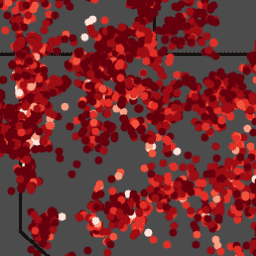
- 数据集可用性
- 2011-05-10T00:00:00Z–2016-12-06T00:00:00Z
- 数据集提供商
- 美国内政部土地管理局 (BLM)
- 标签
说明
自 2011 年以来,土地管理局 (BLM) 一直通过其评估、清查和监控 (AIM) 策略收集实地信息,以了解土地健康状况。迄今为止,已在 BLM 土地上收集了 6,000 多个陆地 AIM 实地样区。BLM AIM 数据归档每年更新一次。 在每个样地收集标准化的核心指标,这些指标在生态学上具有相关性,并且与牧区健康状况密切相关。这些指标可反映生物完整性、土壤和场地稳定性以及水文功能。陆地样地测量包括裸露地表覆盖率(以分数表示)、植被组成和高度、需要管理的植物、非本地入侵物种、植物冠层空隙、物种丰富度和土壤团聚体稳定性。AIM 是美国西部联邦土地上最广泛的公开可用样地测量数据集之一,可与遥感图像和其他地理空间信息集成,用于各种分析、分类和验证目的。
此数据集的创建目的是根据 BLM 政策监控国家级 BLM 资源的状态、状况和趋势。如需了解收集这些数据所用的方法,请参阅景观工具箱和《监测手册》(第 2 版)。在不了解抽样设计是如何绘制的情况下,或者在未根据抽样设计计算点的空间权重的情况下,不应将这些数据用于统计或空间推理。
此要素类包含在全国范围内收集的监测数据,用于了解 BLM 土地上资源的状态、状况和趋势。数据是根据 BLM 评估、清查和监控 (AIM) 策略收集的。AIM 策略规定了概率抽样设计、标准核心指标和方法、电子数据采集和管理,以及与遥感的集成。属性包括 BLM 陆地核心指标:裸露地面、植被组成、需要管理的植物物种、非本地入侵物种和树冠间隙百分比(有关属性的详细信息,请参阅实体/属性部分)。数据由 BLM 现场办公室、BLM 区和/或附属现场工作人员在 BLM 国家运营中心的支持下收集和管理。数据存储在 BLM 国家运营中心的集中式数据库 (TerrADat) 中。
数据由 BLM 和合作伙伴组织的训练有素的数据收集员收集。他们遵循了 BLM 核心陆地数据收集协议。使用 Database for Inventory, Monitoring, and Assessment 以电子方式捕获数据。 这些数据由数据收集器管理,并接受 BLM 外地办事处、州办事处和国家运营中心的监督。此数据集已通过严格的质量保证/质量控制流程,以确保数据质量。
表架构
表架构
| 名称 | 类型 | 说明 |
|---|---|---|
| BareSoilCover_FH | 双精度 | 样地中土壤的基底覆盖率,不包括上方有覆盖物的土壤。例如,如果某个点上是裸土上的山艾树,则不会计入此指标。此指标源自线点截距法(每个地块上三条样线上的 150 个点)。 |
| DateEstablished | STRING | DIMA 中地块的建立日期,格式为 YYYY/MM/DD HH:MM:SS |
| DateLoadedInDb | STRING | 库存、监控和评估数据库 (DIMA) 上传到 TerrADat 的日期。遵循标准日期格式,但会随数据收集年份而变化 (YYYY-09-01)。 |
| DateVisited | STRING | 在样地收集数据的日期,格式为 YYYY/MM/DD HH:MM:SS |
| EcologicalSiteId | STRING | 指生态站点的唯一 ID,NRCS 将其定义为“一种具有特定特征的独特土地,与其他类型的土地不同,它能够产生独特类型和数量的植被”。ID 来自生态站信息系统。 |
| GapPct_25_50 | 双精度 | 地块中植物冠层间隙(大小为 25-50 厘米)所占地块土壤表面的百分比。此指标使用间隙截取法(每个地块三条样线)进行测量。 |
| GapPct_51_100 | 双精度 | 地块中植物冠层之间大小为 50-100 厘米的间隙所覆盖的土壤表面百分比。此指标使用间隙截取法(每个地块三条样线)进行测量。 |
| GapPct_101_200 | 双精度 | 地块中植物冠层之间大小为 101-200 厘米的空隙所占地块土壤表面的百分比。此指标使用间隙截取法(每个地块三条样线)进行测量。 |
| GapPct_200_plus | 双精度 | 地块中植物冠层间大于 200 厘米的空隙所占的土壤表面积百分比。 此指标使用间隙截距法(每个地块三条样线)进行测量。 |
| GapPct_25_plus | 双精度 | 地块中大于 25 厘米的植物冠层间隙所占的土壤表面百分比。 此指标使用间隙截距法(每个地块三条样线)进行测量。 |
| HerbaceousHgt_Avg | 双精度 | 地块中草本植物的平均高度。这是使用植被高度法(每个地块 3 条样线上的 30 个点)收集的。 |
| InvAnnForbCover_AH | 双精度 | 地块中非本地入侵性一年生草本植物的覆盖率。此指标源自线点截距法(每个地块上三条样线上的 150 个点)。非本地入侵状态和生长形态由当地自然资源专家指定,通常是在咨询美国农业部 PLANTS 数据库后指定。 |
| InvAnnForbGrassCover_AH | 双精度 | 样地中非本地入侵性一年生草本植物和草的覆盖率。此指标源自线点截距法(每个地块上三条样线的 150 个点)。非本地入侵性状态和生长形态由当地自然资源专家指定,通常是在咨询美国农业部 PLANTS 数据库后指定。 |
| InvAnnGrassCover_AH | 双精度 | 地块中非本地入侵性一年生禾草的覆盖率。此指标源自线点截距法(每个地块上三条样线上的 150 个点)。非本地入侵状态和生长形态由当地自然资源专家指定,通常是在咨询美国农业部 PLANTS 数据库后指定。 |
| InvPerenForbCover_AH | 双精度 | 样地中非本地入侵性多年生草本植物的覆盖率。此指标源自线点截距法(每个地块上三条样线上的 150 个点)。非本地入侵状态和生长形态由当地自然资源专家指定,通常是在咨询美国农业部 PLANTS 数据库后指定。 |
| InvPerenForbGrassCover_AH | 双精度 | 样地中非本地入侵性多年生草本植物和草的覆盖率。此指标源自线点截距法(每个地块上三条样线的 150 个点)。非本地入侵性状态和生长形态由当地自然资源专家指定,通常是在咨询美国农业部 PLANTS 数据库后指定。 |
| InvPerenGrassCover_AH | 双精度 | 地块中非本地入侵性多年生草的覆盖率。此指标源自线点截距法(每个地块上三条样线上的 150 个点)。非本地入侵状态和生长形态由当地自然资源专家指定,通常是在咨询美国农业部 PLANTS 数据库后指定。 |
| InvPerenGrassHgt_Avg | 双精度 | 样地内入侵性多年生禾草的平均高度。这些数据是使用植被高度方法(每个地块 3 条样线上的 30 个点)收集的。 |
| InvPlantCover_AH | 双精度 | 样地内非本地入侵植物的覆盖率。 此指标是通过线点截距法(每个地块上三条样线上的 150 个点)得出的。非本地入侵性状态和生长形态由当地自然资源专家指定,通常是在咨询美国农业部 PLANTS 数据库后指定。 |
| InvPlant_NumSp | 双精度 | 在定时搜索(物种清单)期间,在整个样地面积内发现的非本地入侵植物物种的数量。 非本地入侵性状态和生长形态由当地自然资源专家指定,通常是在咨询美国农业部 PLANTS 数据库后指定。 |
| InvShrubCover_AH | 双精度 | 地块中非本地入侵性灌木的覆盖率。 此指标是通过线点截距法(每个地块上三条样线上的 150 个点)得出的。非本地入侵性状态和生长形态由当地自然资源专家指定,通常是在咨询美国农业部 PLANTS 数据库后指定。 |
| InvSubShrubCover_AH | 双精度 | 样地中非本地入侵性半灌木的覆盖度。 此指标是通过线点截距法(每个地块上三条样线上的 150 个点)得出的。非本地入侵性状态和生长形态由当地自然资源专家指定,通常是在咨询美国农业部 PLANTS 数据库后指定。 |
| InvSucculentCover_AH | 双精度 | 样地中非本地入侵性多肉植物的覆盖率。 此指标是通过线点截距法(每个地块上三条样线上的 150 个点)得出的。非本地入侵性状态和生长形态由当地自然资源专家指定,通常是在咨询美国农业部 PLANTS 数据库后指定。 |
| InvTreeCover_AH | 双精度 | 样地中非本地入侵树木的覆盖率。 此指标是通过线点截距法(每个地块上三条样线上的 150 个点)得出的。非本地入侵性状态和生长形态由当地自然资源专家指定,通常是在咨询美国农业部 PLANTS 数据库后指定。 |
| NonInvAnnForbCover_AH | 双精度 | 样地中非入侵性一年生草本植物的覆盖率。 此指标是通过线点截距法(每个地块上三条样线上的 150 个点)得出的。非本地入侵性状态和生长形态由当地自然资源专家指定,通常是在咨询美国农业部 PLANTS 数据库后指定。 |
| NonInvAnnForbGrassCover_AH | 双精度 | 样地内非入侵性一年生草本植物和草类的覆盖率。此指标源自线点截距法(每个地块上三条样线上的 150 个点)。非本地入侵状态和生长形态由当地自然资源专家指定,通常是在咨询美国农业部 PLANTS 数据库后指定。 |
| NonInvAnnGrassCover_AH | 双精度 | 地块中非入侵性一年生草的覆盖率。 此指标是通过线点截距法(每个地块上三条样线上的 150 个点)得出的。非本地入侵性状态和生长形态由当地自然资源专家指定,通常是在咨询美国农业部 PLANTS 数据库后指定。 |
| NonInvPerenForbCover_AH | 双精度 | 样地中非入侵性多年生草本植物的覆盖率。 此指标是通过线点截距法(每个地块上三条样线上的 150 个点)得出的。非本地入侵性状态和生长形态由当地自然资源专家指定,通常是在咨询美国农业部 PLANTS 数据库后指定。 |
| NonInvPerenForbGrassCover_AH | 双精度 | 地块中非侵入性多年生草本植物和草的覆盖率。此指标源自线点截距法(每个地块上三条样线上的 150 个点)。非本地入侵状态和生长形态由当地自然资源专家指定,通常是在咨询美国农业部 PLANTS 数据库后指定。 |
| NonInvPerenGrassCover_AH | 双精度 | 地块中非侵入性多年生草的覆盖率。 此指标是通过线点截距法(每个地块上三条样线上的 150 个点)得出的。非本地入侵性状态和生长形态由当地自然资源专家指定,通常是在咨询美国农业部 PLANTS 数据库后指定。 |
| NonInvPerenGrassHgt_Avg | 双精度 | 样地内非入侵性多年生草的平均高度。这些数据是使用植被高度方法(每个地块 3 条样线上的 30 个点)收集的。 |
| NonInvShrubCover_AH | 双精度 | 地块中非入侵性灌木的覆盖率。此指标源自线点截距法(每个样地有 3 条样线,每条样线有 150 个点)。非本地入侵性状态和生长形态由当地自然资源专家指定,通常是在咨询美国农业部 PLANTS 数据库后指定。 |
| NonInvSubShrubCover_AH | 双精度 | 地块中非入侵性灌木的覆盖率。此指标源自线点截距法(每个样地有 3 条样线,每条样线有 150 个点)。非本地入侵性状态和生长形态由当地自然资源专家指定,通常是在咨询美国农业部 PLANTS 数据库后指定。 |
| NonInvSucculentCover_AH | 双精度 | 地块中非入侵性多肉植物的覆盖率。此指标源自线点截距法(每个样地有 3 条样线,每条样线有 150 个点)。非本地入侵性状态和生长形态由当地自然资源专家指定,通常是在咨询美国农业部 PLANTS 数据库后指定。 |
| NonInvTreeCover_AH | 双精度 | 地块中非入侵性树木的覆盖率。此指标源自线点截距法(每个样地有 3 条样线,每条样线有 150 个点)。非本地入侵性状态和生长形态由当地自然资源专家指定,通常是在咨询美国农业部 PLANTS 数据库后指定。 |
| OtherShrubHgt_Avg | 双精度 | 地块内非艾蒿灌木(是艾鸡偏好的灌木)的平均高度。美国农业部植物数据库中的其他灌木物种代码包括:AMAL2、AMUT、ATCO、CEVE、CHNA2、CHVI8、GRSP、GUSA2、JUOC、JUOS、KRLA2、PAMY、PUTR2、ROWO、SAVE4、SYAL、SYOR2 和 TECA2。这些数据是使用植被高度协议(每个样地 3 条样线上的 30 个点)收集的。 |
| PlotID | STRING | 数据收集器为每个数据收集地点或地块分配的名称。格式各不相同。 不同地块和项目之间可能存在重复的地块 ID,但同一地块内不会存在重复的地块 ID。每个 AIM 地块都是一个半径为 55 米(直径为 110 米)的圆的中心点,在该圆内收集了监测指标(数据集属性)。使用所需推理空间内的空间平衡抽样设计随机选择点。大多数属性都是沿着三条 50 米或 25 米的样线收集的,这些样线与中心点相距 5 米,并以 0 度、120 度和 240 度的角度从中心点向外辐射。 |
| PlotKey | STRING | 与每个地块位置相关联的唯一数字 ID。 在 DIMA 中首次创建图表时,系统会自动生成此属性。未来对同一地块的访问通常使用相同的地块密钥。 |
| PrimaryKey | STRING | 每个地块的唯一标识符。它包括地块密钥以及加载到 TerrADat 中的数据。 |
| ProjectName | STRING | 指收集数据时所处的更广泛的项目区域。通常包括州、土地管理局办事处和年份。 |
| SagebrushCover_AH | 双精度 | 地块中山艾树的覆盖率。此指标源自线点截距法(每个地块上三条样线上的 150 个点)。美国农业部 PLANTS 数据库中的山艾树物种代码包括:ARAR8;ARARL3;ARARL;ARNO4;ARARN;ARBI3;ARCAB3;ARBO5;ARCAC5;ARCAV2;ARCAV;ARFR4;ARPA16;ARPE6;ARPY2;ARRI2;PIDE4;ARSP5;ARTRS2;ARTRT;ARTRV;ARTRX;ARTRV;ARTRP4;ARTRW8;ARTRW;ARTRT2;ARTRR2;ARTRR4 和 SPAR2。 |
| SagebrushHgt_Avg | 双精度 | 地块中山艾树的平均高度。这是使用植被高度法(每个样地 3 条样线上的 30 个点)收集的。美国农业部 PLANTS 数据库中的山艾树物种代码包括:ARAR8;ARARL3;ARARL;ARNO4;ARARN;ARBI3;ARCAB3;ARBO5;ARCAC5;ARCAV2;ARCAV;ARFR4;ARPA16;ARPE6;ARPY2;ARRI2;PIDE4;ARSP5;ARTRS2;ARTRT;ARTRV;ARTRX;ARTRV;ARTRP4;ARTRW8;ARTRW;ARTRT2;ARTRR2;ARTRR4 和 SPAR2。 |
| SiteID | STRING | 数据收集器使用此属性按地块类型或管理区域等对地块进行分组。常见值是管理单位(例如地块)的名称或数据收集的主题(例如土地复垦)。 |
| SoilStability_All | 双精度 | 地块中所有样本的平均土壤团聚体稳定性。此指标使用土壤团聚体稳定性测试(每个地块最多 18 个样本)进行衡量。在此测试中,稳定性范围为 1-6,其中 1 表示最不稳定,6 表示最稳定。 |
| SoilStability_Protected | 双精度 | 地块中在植物冠层下采集的样本的平均土壤团聚体稳定性。此指标通过土壤团聚体稳定性测试(每个地块最多 18 个样本)进行测量。在此测试中,稳定性范围为 1-6,其中 1 表示最不稳定,6 表示最稳定。 |
| SoilStability_Unprotected | 双精度 | 样地内植物冠层之间(例如,上方没有直接覆盖物)采集的样本的平均土壤团聚体稳定性。此指标通过土壤团聚体稳定性测试(每个地块最多 18 个样本)进行测量。在此测试中,稳定性范围为 1-6,其中 1 表示最不稳定,6 表示最稳定。 |
| TotalFoliarCover_FH | 双精度 | 地块中植物的叶面覆盖率。此指标源自线点截距法(每个地块上三条样线上的 150 个点)。 |
| WoodyHgt_Avg | 双精度 | 地块内木本植物的平均高度。这是使用植被高度方法(每个样地 3 条样线上的 30 个点)收集的。 |
使用条款
使用条款
这些数据被视为公共领域数据。
这些数据由土地管理局 (BLM)“按原样”提供,可能包含错误或遗漏。用户承担与使用这些数据相关的所有风险,并自行负责确定这些数据是否适合用户的预期用途。这些数据中包含的信息是动态的,可能会随时间而变化。这些数据并不比其来源更好,并且规模和准确性可能会因数据集而异。这些数据可能不具备潜在用户可能会考虑的准确性、分辨率、完整性、及时性或其他特征。建议用户仔细考虑与这些数据关联的元数据文件的内容。这些数据既不是法律文件,也不是土地测量数据,不得用作此类数据。官方记录最多可在 1 个 BLM 办事处中引用。请向获取数据的 BLM 办事处报告数据中的任何错误。在基于这些数据派生的任何产品中,都应将 BLM 视为数据源。任何希望修改数据的用户都应说明他们执行的修改类型。用户不得歪曲数据,也不得暗示所做的更改已获得 BLM 的批准或认可。美国土地管理局可能会在不通知的情况下更新这些数据。
BLM 对错误或遗漏不承担任何责任。美国土地管理局 (BLM) 不保证这些数据在个人使用或与其他数据一起汇总使用时的准确性、可靠性或完整性;向承包商、合作伙伴或其他人分发这些数据也不构成对个人使用或与其他数据一起汇总使用这些数据的任何此类保证。尽管这些数据已在 BLM 的计算机上成功处理,但 BLM 对在任何其他系统上使用这些数据或将这些数据用于一般或科学目的不作任何明示或暗示的保证,分发这些数据的事实也不构成或暗示任何此类保证。在任何情况下,美国土地管理局均不对任何后果性、附带性、间接性、特殊性或侵权性损害(包括但不限于因使用或依赖地理数据或因美国土地管理局交付、安装、操作或支持而造成的任何利润损失)承担任何责任。
使用 Earth Engine 探索
代码编辑器 (JavaScript)
var greens = ee.List([ '#00441B', '#00682A', '#37A055', '#5DB96B', '#AEDEA7', '#E7F6E2', '#F7FCF5' ]); var reds = ee.List([ '#67000D', '#9E0D14', '#E32F27', '#F6553D', '#FCA082', '#FEE2D5', '#FFF5F0' ]); function normalize(value, min, max) { return value.subtract(min).divide(ee.Number(max).subtract(min)); } function setColor(feature, property, min, max, palette) { var value = normalize(feature.getNumber(property), min, max) .multiply(palette.size()) .min(palette.size().subtract(1)) .max(0); return feature.set({style: {color: palette.get(value.int())}}); } var fc = ee.FeatureCollection('BLM/AIM/v1/TerrADat/TerrestrialAIM'); var woodyHeightStyle = function(f) { return setColor(f, 'WoodyHgt_Avg', 0, 100, greens); }; var bareSoilStyle = function(f) { return setColor(f, 'BareSoilCover_FH', 0, 100, reds); }; var treeHeight = fc.filter('WoodyHgt_Avg > 1').map(woodyHeightStyle); var bareSoil = fc.filter('BareSoilCover_FH > 1').map(bareSoilStyle); Map.addLayer(bareSoil.style({styleProperty: 'style', pointSize: 3})); Map.addLayer(treeHeight.style({styleProperty: 'style', pointSize: 1})); Map.setCenter(-110, 40, 6);
以 FeatureView 形式直观呈现
FeatureView 是 FeatureCollection 的只读加速表示形式。如需了解详情,请访问
FeatureView 文档。
代码编辑器 (JavaScript)
var fvLayer = ui.Map.FeatureViewLayer( 'BLM/AIM/v1/TerrADat/TerrestrialAIM_FeatureView'); var visParams = { isVisible: false, pointSize: 7, rules: [ { filter: ee.Filter.expression('WoodyHgt_Avg > 1'), isVisible: true, color: { property: 'WoodyHgt_Avg', mode: 'linear', palette: ['00441b', '00682a', '37a055', '5db96b', 'aedea7', 'e7f6e2', 'f7fcf5'], min: 0, max: 100 } } ] }; fvLayer.setVisParams(visParams); fvLayer.setName('Average woody plant height'); Map.setCenter(-110, 40, 6); Map.add(fvLayer);
